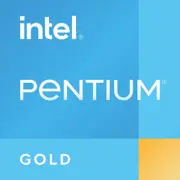Intel Pentium Gold G6405

Intel Pentium Gold G6405: Budget Processor for Basic Tasks in 2025
Overview of capabilities, compatibility, and use cases
1. Key Features: Architecture and Performance
Codename and Fabrication Process
The Intel Pentium Gold G6405 processor, released in 2020, is based on the Comet Lake architecture and is manufactured using a 14nm fabrication process. Despite the dominance of 7nm and 5nm chips by 2025 (such as AMD Ryzen 8000 or Intel Core 14th Gen), the G6405 remains popular in the budget segment due to its low cost (around $50–60 in the new devices market).
Cores, Threads, and Cache
- 2 cores / 4 threads thanks to Hyper-Threading.
- Base frequency: 4.1 GHz (no turbo mode).
- L3 Cache: 4 MB.
Performance
- Geekbench 6: 847 (single-core), 1759 (multi-core).
For comparison: the modern Core i3-14100 (4 cores / 8 threads) scores about ~1800/6000 points but costs three times as much.
- Integrated Graphics: Intel UHD Graphics 610. Suitable for 4K video (with hardware decoding) and light gaming (e.g., Minecraft on low settings).
Key Features
- Support for DDR4-2666.
- Energy efficiency (TDP of 58W).
- Compatibility with Windows 11 (TPM module required on the motherboard).
2. Compatible Motherboards
Socket and Chipsets
- LGA 1200 socket — used in motherboards for Comet Lake processors (10th generation).
- Chipsets:
- H410 / B460 — budget options (from $50). Example: ASRock H410M-HDV.
- H470 / Z490 — advanced features (memory overclocking, more ports). Example: Gigabyte Z490 UD.
Selection Considerations
- For G6405, an H410 board is sufficient: overclocking is not supported, and 2 DDR4 slots are enough for basic tasks.
- If planning to upgrade to Core i5/i7 Comet Lake, it's better to choose a B460 with cooled VRM modules.
3. Supported Memory Types
- Type: Only DDR4 (DDR5 not supported).
- Frequency: Up to 2666 MHz (on H410/B460 chipsets). On Z490, it can be overclocked to 2933 MHz, but this is not critical for G6405.
- Recommendations:
- Use two modules (e.g., 2x8 GB) to enable dual-channel mode.
- Budget DDR4-2666 (16 GB) kits cost around $40.
4. Power Supply Recommendations
- CPU TDP: 58W.
- Integrated Graphics: UHD 610 consumes up to 15W.
- Recommended PSU:
- For a system without a discrete GPU, a 300–400W unit is sufficient (e.g., be quiet! System Power 10, 400W, $45).
- If adding a GPU like the NVIDIA GTX 1650 (TDP 75W), a PSU of 450–500W will be required.
Important: Do not skimp on the PSU. Even for a budget build, choose models with an 80+ Bronze certification.
5. Pros and Cons of the Pentium Gold G6405
Pros:
- Price: One of the cheapest new processors (around $60).
- Energy efficiency: Suitable for compact PCs and office systems.
- Support for modern OS: Windows 10/11, Linux.
Cons:
- 2 cores: Multitasking is limited (e.g., video streaming + browsing with a dozen tabs can cause slowdowns).
- Weak graphics: UHD 610 struggles with AAA games even on minimum settings.
- Outdated fabrication process: 14nm vs. 7nm competitors.
6. Use Cases
Office and Study
- Working with documents, browsers, Zoom.
- Example: A build based on G6405, 8 GB DDR4, 256 GB SSD — perfect for Word and Excel.
Multimedia
- Viewing 4K videos (Netflix, YouTube) thanks to VP9 and HEVC decoding.
- Connection to TV via HDMI 2.0.
Light Gaming
- Minecraft (40–60 FPS on low settings), CS:GO (30–40 FPS at 720p).
Not Suitable For:
- Video editing, 3D rendering.
- Modern games (e.g., Cyberpunk 2077 or Starfield).
7. Comparison with Competitors
AMD Athlon 3000G (price: ~$45)
- Pros: Cheaper, unlocked multiplier.
- Cons: No Hyper-Threading (2 cores / 2 threads), weaker in single-threaded tasks (Geekbench 6 Single Core: ~600).
AMD Ryzen 3 3200G (price: ~$80)
- Pros: 4 cores / 4 threads, Vega 8 graphics (twice as fast as UHD 610).
- Cons: Higher TDP (65W), requires more expensive AM4 motherboards.
Conclusion: G6405 is better in energy efficiency and price but lags in multitasking and graphics performance.
8. Assembly Tips for a G6405-Based PC
1. Motherboard: Choose H410/B460 with HDMI output (e.g., ASUS Prime H410M-E).
2. Memory: 2x8 GB DDR4-2666 (Crucial, Kingston).
3. Storage: Use an SSD (WD Green 240 GB, $25).
4. Cooling: The stock cooler is sufficient — minimal noise.
5. Case: Compact Mini-Tower (Deepcool MATREXX 30, $35).
Example Build (Price: ~$250 without OS):
- CPU: G6405 ($60)
- Motherboard: ASRock H410M-HDV ($55)
- Memory: 16 GB DDR4-2666 ($40)
- SSD: 240 GB ($25)
- PSU: 400W ($45)
- Case: $25
9. Final Conclusion: Who Should Consider the Pentium Gold G6405?
Choose this processor if:
- The budget is limited, and tasks are simple: office work, study, internet browsing.
- You need a quiet and compact PC for a media center.
- You are building a system for elderly people or children (minimalism, reliability).
Alternatives for 2025:
- For gaming: Intel Core i3-14100 + discrete graphics card.
- For multitasking: AMD Ryzen 5 5500 (6 cores, $120).
The Pentium Gold G6405 is not powerful but a practical choice for those who value simplicity and savings.
Basic
CPU Specifications
Memory Specifications
GPU Specifications
Miscellaneous
Benchmarks
Compared to Other CPU
Share in social media
Or Link To Us
<a href="https://cputronic.com/cpu/intel-pentium-gold-g6405" target="_blank">Intel Pentium Gold G6405</a>